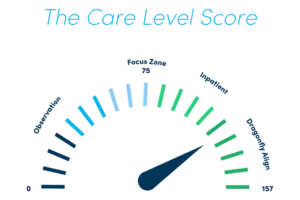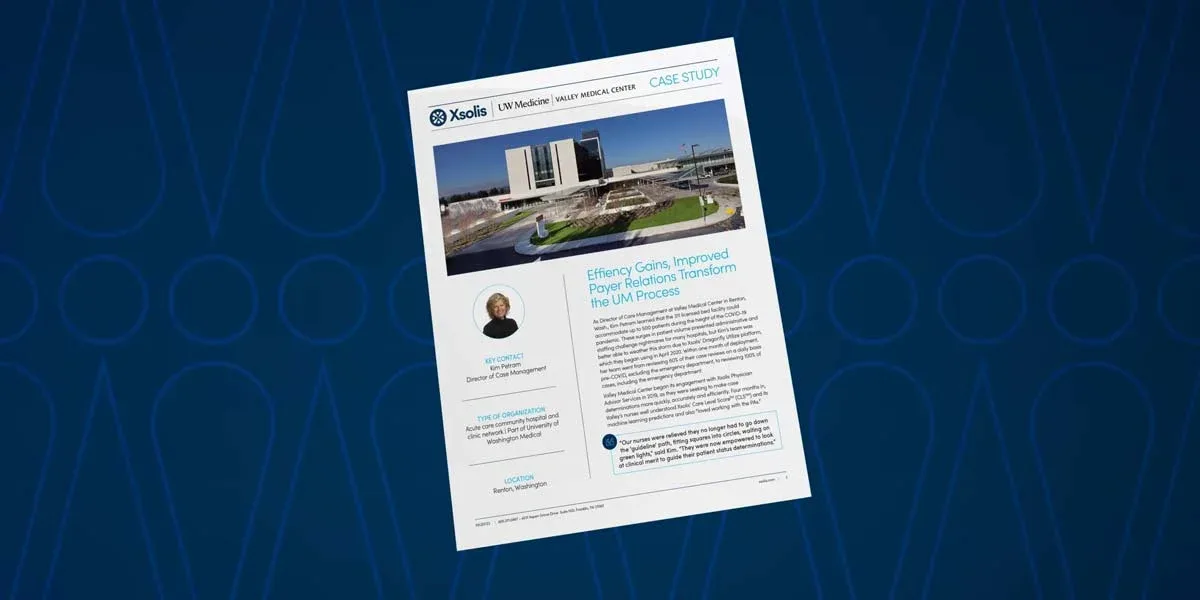Valley Medical Center
 As Director of Care Management at Valley Medical Center in Renton, Wash., Kim Petram learned that the 311 licensed bed facility could accommodate up to 500 patients during the height of the COVID-19 pandemic. These surges in patient volume presented administrative and staffing challenge nightmares for many hospitals, but Kim’s team was better able to weather this storm due to Xsolis’ CORTEX.UR platform, now known as Dragonfly Utilize, which they began using in April 2020. Within one month of deployment, her team went from reviewing 60% of their case reviews on a daily basis pre-COVID, excluding the Emergency Department, to reviewing 100% of cases, including the Emergency Department.
As Director of Care Management at Valley Medical Center in Renton, Wash., Kim Petram learned that the 311 licensed bed facility could accommodate up to 500 patients during the height of the COVID-19 pandemic. These surges in patient volume presented administrative and staffing challenge nightmares for many hospitals, but Kim’s team was better able to weather this storm due to Xsolis’ CORTEX.UR platform, now known as Dragonfly Utilize, which they began using in April 2020. Within one month of deployment, her team went from reviewing 60% of their case reviews on a daily basis pre-COVID, excluding the Emergency Department, to reviewing 100% of cases, including the Emergency Department.
Looking to mitigate audit risk, a phased approach was the winning solution
Kim learned about Xsolis at a conference in 2019 and thought its Dragonfly solution, previously called CORTEX sounded too good to be true. At the time, Valley was looking for a solution that could right-size their observation (OBS) rates to keep them more within Centers for Medicare and Medicaid Services (CMS) and other local facilities’ averages. Kim was able to speak with several Dragonfly customers that shared candidly about their experiences. She was able to validate that what seemed impossible – a more efficient way of reviewing cases and proving medical necessity – was truly being delivered with Xsolis’ solutions.
Over a period of six months, Kim worked with Xsolis to show Valley Medical Center’s customized, predicted ROI for the purchase, then she shopped the benefits to her C-suite leadership, internal IT leaders and other key stakeholders to gain their approval. Because Valley had to cease contracts with other vendors, she opted for a phased approach to enter an engagement with Xsolis.
First up? Physician Advisory (PA) Services. Kim knew that Valley Medical Center needed to move away from outsourced PA Services to help them make case determinations more quickly, accurately, and efficiently. Four months in, Valley’s nurses well understood Xsolis’ Care Level Score™ (CLS™) and its MeL predictions and also “loved working with the PAs.”
“Our nurses were relieved they no longer had to go down the ‘guideline’ path, fitting squares into circles, waiting on green lights,” said Kim. “They were now empowered to look at clinical merit to guide their patient status determinations.”
Success with PA Services set the stage for expanded efficiencies with Dragonfly
 This helped grease the wheels for an easy implementation of Dragonfly Utilize, which was conducted remotely in April 2020. Within one month’s time, Valley Medical’s team became highly proficient at knowing when to review versus when to escalate to PA Services. And with their most important cases, they could more easily keep an eye on those patients and make appropriate care and patient status decisions quickly as the clinical indications changed. Imbedding Dragonfly into their EMR created more efficient workflows – “It’s seamless, and the CLS is highly accurate,” Kim said.
This helped grease the wheels for an easy implementation of Dragonfly Utilize, which was conducted remotely in April 2020. Within one month’s time, Valley Medical’s team became highly proficient at knowing when to review versus when to escalate to PA Services. And with their most important cases, they could more easily keep an eye on those patients and make appropriate care and patient status decisions quickly as the clinical indications changed. Imbedding Dragonfly into their EMR created more efficient workflows – “It’s seamless, and the CLS is highly accurate,” Kim said.
“Dragonfly [CORTEX] allowed our team to rapidly increase the use of their ‘clinical eyes’ to make decisions quickly and with 100% accuracy,” Kim said.
Benefits Valley Medical Center realized within its first six months:
- Moving from 60% of case reviews, not including the emergency department, to 100% of case reviews, including the emergency department – a 67% improvement with case review volume.
- Reducing the extended OBS rates (those patients who are discharged in an OBS status who stay longer than two midnights) from 36.2% to 27.3% – marking a 25% improvement. Althought not an initial goal for Valley Medical Center, Xsolis’ robust reporting capabilities revealed this as an additional area for improvement which has yielded another big win, according to Kim.
- Mitigating audit risk by right-sizing OBS rates from 4% to around 13%, “which is a number I’m happy with,” said Kim.
More timely submissions of claims, right out of the door – without having to downgrade or go through post-discharge work with their financial services department and revenue cycle departments. - Consistently identifying correct patient status determinations before discharge, based on risk stratification instead of a census list.
- Dragonfly’s integration assists in capturing certain DRGs Valley manages under the CMS BPCI-A bundled payment program, facilitating easy identification of these cases.
Improved payer connections, flexibility and job satisfaction for staff
“Our Washington state Medicaid plans and all managed health plans are run differently here, and our payer connections can be tricky to manage,” said Kim. “But our payers quickly recognized the shared benefits of working in Dragonfly, which has led to conversations about what other improvements we can accomplish together within a shared and collaborate framework. This has been a new experience for them.”
By submitting claims to payers via Dragonfly, Kim and her team received positive feedback about the platform’s benefits to payers as well, which led to requested education on additional benefits.Their payers cite improved, shared views of a patient’s true medical condition, and that they receive and review cases more efficiently within Dragonfly.
Even during COVID, Valley Medical was able to manage their patient volumes with the same amount of staff, according to Kim. Implementing a “new way of doing things” couldn’t have come at a better time – empowering the UM team with Dragonfly enabled them to more successfully weather the storm that COVID and other unknowns will continue to bring for the healthcare industry.
Change is always hard, admits Kim, particularly when you have staff who have been doing things a certain way their whole career. Thus is the Catch 22 in utilization management, because you are dealing with incredibly experienced nurses who are not able to work at the top of their license due to inefficient processes that relegate them to checking boxes.
Kim sought improvement as her personal responsibility – “utilization management needs to move to the next level” – and the benefits of leading the way have paid off. Partnering with Xsolis allowed for staff reallocation for more efficiency and job satisfaction – for example, one lead UM specialist was able to purely focus on appeals and denials resolution management. “Our nurses are very happy and love their UM job,” she said.
“At the end of the day, everyone knows the payer and the facility might be using the same guidelines and still disagree about the status of the case,” said Kim. “The way utilization management works now at Valley Medical Center is entirely different, and we’ve been able to move away from the pre-formulated guideline methodology to do our best work.”
